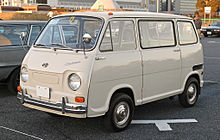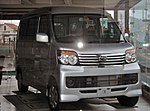Subaru Sambar
The Subaru Sambar was launched in 1961 by Subaru as the first Japanese Keitora (軽 ト ラ), short for “Kei-class truck”, on the Japanese market. Model variants are minibuses , panel vans and flatbed trucks . The type is produced in Japan , China and Korea .
Since its launch, the Sambar has a rear engine with rear-wheel drive . All-wheel drive has been available as an option since 1980 . In Europe, the Sambar was converted into an electric car by Elcat Electric Vehicles from Finland .
From 1984 the Sambar was in Europe as Subaru 600/700 (for example Germany ), Subaru Domingo (for example Austria , Switzerland ), Subaru Sumo ( United Kingdom ) or Subaru Columbus ( Sweden ). The reason for this different naming was a possible conflict with Volkswagen when using the name Sambar. Shortly after the introduction of the Subaru 600/700, Subaru held a name-finding competition, making the model the Subaru Libero in most European markets .
In 1990 the model in the minibus version was renamed Subaru Sambar Dias-Wagon . Since 2009 this is no longer based on the Sambar, but on the Van Daihatsu Atrai .
The 7th generation sambar has been produced by Daihatsu since April 2012 based on the Daihatsu Hijet .
First generation (1961–1966)
The Sambar was presented at the Tokyo Motor Show in 1960 . From the start, the Sambar had a rear-wheel drive engine and the wheels were individually suspended . The engine, called the EK range, was also used in the Subaru 360 . It was accessible through a hatch in the rear of the vehicle. A panel van and a minibus version were available. The chassis was a ladder frame . The front doors were hinged at the back .
The Sambar was developed to offer a model that could carry small loads without leaving the kei car class , which is important in Japan . In 1961 the Suzulight Carry (later known to us as the Suzuki Carry ) came onto the market, followed by the Honda T360 in 1963, the Daihatsu Hijet in 1964 and the Mitsubishi Minicab in 1966 .
Second generation (1966–1973)
In January 1966 the Sambar appeared with a new body, but the same chassis. For the first time, a platform truck called a truck version in Japan was introduced. As an engine, there was still the 356 cm³ EK engine with now but 20 hp output, which had been used in the Subaru 360 since July 1964. A high roof was offered as an option from 1968.
Beginning with the 1970 model year, the engine was accessible from outside the rear of the vehicle by means of a flap, and the suicide doors were replaced by conventionally hinged doors. At the same time, to improve safety, a fully padded dashboard was introduced, which came from the new Subaru R-2 . The body has been modernized at the front and adapted to the design of the new Subaru L-series .
The Toyota MiniAce appeared as a new competitor in the segment in 1967 , the Mazda Porter in 1968 and the most modern representative of the segment with a water-cooled engine, the Datsun Sunny Cab, in 1969 .
Third generation (export Subaru 600/700) (1973–1982)
The third generation appeared on February 10, 1973, this time nicknamed Tsutomu Tsuyoshi Sambar, due to an advertising campaign. The two-stroke two-cylinder 356 cm³ engine was now water-cooled. From February 1976, the water-cooled EK21 four-stroke engine was introduced from the Subaru Rex to reduce emissions. From now on, the washer fluid for the windshield was transported by means of an electric pump instead of the previous pedal operation.
Three months later, the 490 cc (EK22) engine was introduced as an option. This was replaced in March 1977 by the 550 cm³ (EK23) engine. Now the export of the Sambar also started as Subaru 700 with a 665 cm³ version of the EK-23 engine. Side sliding doors were now also available on both sides; in export, these were installed as standard. A central sunroof was optionally available from 1979.
In 1980, for the first time, selectable all-wheel drive was offered for all body variants. This led to initial sales successes in Europe, where only the panel van and minibus variants were offered here.
Fourth generation (Export Subaru 600) / Sambar Try (Export Subaru 700) (1982–1990)
The fourth generation of the Sambar appeared on May 9, 1982. MacPherson struts were now installed for the front axle. The wheel size was increased from 10 to 12 inches, allowing larger drum brakes to be used on all four wheels. The all-wheel drive model was now available with a dual-range transmission. For the first time there was the version Sambar Try (Europa Subaru 700), a better equipped model of the minibus version.
While the model was offered on the home market with the EK23 engine (544 cm³, 2 cylinders, 21 kW / 29 PS), the export versions, which were initially offered as the Subaru 600 , received an enlarged 665 cm³ version of the same engine, making the Output increased to 23 kW (31 hp). The EN05 four-cylinder engine from the Subaru Rex was not offered because it would have required a lot of modifications due to the rear engine principle.
In 1983, as the Subaru 700 , high-roof versions with the 3-cylinder EF10-1000 cm³ engine were again available in Europe. The normal / flat roof version with the smaller 665 cm³ engine was offered as the Subaru 600 .
From 1984 the Subaru 600/700 was no longer officially offered in Europe and was only imported through independent dealers. The background was the enlargement in the area of the front and rear bumpers to improve occupant protection. Because of this and because of the larger engines, the model exceeded the requirements of the kei class. This enlarged version was now offered in Japan as Subaru Domingo and upgraded with better interior equipment such as a standard central sunroof and all-wheel drive. The model was gradually introduced as a minibus or panel van version under the names Subaru Libero (Japanese: Domingo), Subaru Sumo (GB), Subaru Domingo (for example Austria and Switzerland) and Subaru Columbuss (Sweden). Later, the name was standardized in Europe with the exception of Great Britain and Sweden on Subaru Libero , but better equipped versions were partially given the addition of Domingo in its earlier markets.
From January 1987 the central sunroof was equipped with an electric drive as standard. Front disc brakes were now standard equipment. An automatic transmission was also available as an option.
In April 1989 a six-valve engine with 25 kW (34 hp) became the standard engine. The all-wheel drive could no longer be engaged, but was permanently available.
Fifth generation / Sambar Dias Wagon I (1990–1998)
The fifth generation Sambar was introduced in 1990. In the tradition of the Subaru Kei Car range, the EN07 engine known from the Subaru Vivio was installed. This now had four cylinders; with an optional compressor and intercooler , it achieved 55 hp in the Sambar. An automatic transmission was offered in the form of the Subaru EVT system, for the 4WD drive with a viscous coupling and differential lock.
The Sambar Try minibus version was now called Subaru Dias Wagon . In contrast to the normal Sambar, the truck version had round headlights.
In 1992 the model appeared modernized with the 1200 cc EF12 three-cylinder from the Subaru Justy on the home market. Now a maximum of 7 seats were possible in the minibus version. This model was introduced in Europe from 1993 as the new Subaru Libero / Sumo / Columbus.
Based on the Sambar truck, a separate van / minibus was created, on the basis of which a partially individual retro line of the "Sambar Dias Classic" was built from October 1993. This was influenced by the Subaru Vivio bistro models and the retro design popular in Japan in the 1990s.
From October 1995 the EVT transmission was withdrawn from the range in favor of a 3-speed automatic transmission due to customer complaints about driving comfort.
Sixth generation (1999–2012)
Production of the commercial Sambar variants began in March 1999. In 2007, the front design of the Sambar 6 was revised. Production of the Sambar 6 ended on February 28, 2012. At the end of production in 2012, the Sambar u. a. Standard with anti-lock braking system , driver and front passenger airbags and electric windows . The panel van and minibus versions were fitted with electric sliding side doors as standard.
In 2005 General Motors sold its 20% stake in Fuji Heavy Industries , Subaru's parent company. Fuji Heavy Industries has now entered into a cooperation agreement with Toyota , which in 2008 resulted in Toyota taking a 16.5% stake in Fuji Heavy Industries. It was decided that Subaru should no longer develop and build kei cars. The Kei-Car models sold under the Subaru brand are manufactured by other manufacturers from the Toyota group (“ badge engineering ”).
Sambar Dias Wagon II (1999-2009)
The sixth generation was presented at the end of 1998. In that year, the regulations in the K-Car class regarding vehicle size were expanded, from which the Dias Wagon benefited.
The Sambar Dias was only offered with a 3-speed automatic transmission in conjunction with all-wheel drive. The engine output has now been increased to 58 hp as standard with a compressor. A Sambar Dias Classic was also offered until 2002 .
In 2009 the production of the Subaru Sambar Dias Wagon based on the 6th generation Sambar ended.
Sambar Dias Wagon III (since 2009)
The Sambar Dias Wagon III has been around since 2009. It was produced by Daihatsu and largely corresponds to the Daihatsu Atrai .
Seventh generation (since 2012)
The 7th generation has been available since April 2012. It corresponds to the Daihatsu Hijet .
Individual evidence
Web links
- http://www.subaru.jp/sambar/van/index.html Manufacturer's website (Japanese)
- http://www.subaru.ch/htm/738/fr/Lancement_de_la_petite_fourgonnette_Sambar.htm?Geschichte=16616&Categorie=1954_1969 Sambar history on Swiss Subaru website (French)





















